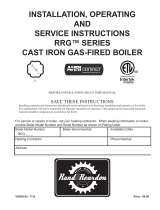
6
II. PRE-INSTALLATION AND BOILER MOUNTING
WARNING
If you do not follow these instructions exactly,
a re or explosion may result causing property
damage or personal injury.
A. INSPECT SHIPMENT carefully for any signs of
damage. All equipment is carefully manufactured,
inspected and packed. Our responsibility ceases upon
delivery of Boiler to the carrier in good condition. Any
claims for damage or shortage in shipment must be led
immediately against the carrier by the consignee. No
claims for variances or shortages will be allowed by
Boiler Manufacturer unless presented within sixty (60)
days after receipt of equipment.
B. BOILER INSTALLATION must conform to the
requirements of the authority having jurisdiction, or in
the absence of such requirements, to:
U.S.A. - National Fuel Gas Code, ANSI Z223.1/
NFPA 54.
CANADA - Natural and Propane Installation Code,
CAN/CSA B149.1.
Where required by authority having jurisdiction,
installation must conform to Standard for Controls and
Safety Devices for Automatically Fired Boilers, ANSI/
ASME CSD-1.
C. These Gas Boilers are DESIGN CERTIFIED FOR
INSTALLATION ON COMBUSTIBLE FLOORING.
DO NOT INSTALL THESE BOILERS ON
CARPETING.
NOTICE
Do not drop boiler. Do not bump boiler jacket
against oor.
D. LOCATE BOILER in front of or behind installation
position before removing Crate. Locate on a level oor
as close to chimney as possible. For basement
installations, provide a solid base such as concrete, if
oor is not level or if water may be encountered on
oor around Boiler.
The boiler shall be installed such that the gas ignition
system components are protected from water (dripping,
spraying, rain, etc.) during boiler operation and service
(circulator replacement, control replacement, etc.).
DANGER
Do not install boiler where gasoline or other
ammable vapors or liquids, or sources of
hydrocarbons (i.e. bleaches, cleaners, chemicals,
sprays, paint removers, fabric softeners, etc.) are
used or stored.
CAUTION
Avoid operating this boiler in an environment
where saw dust, loose insulation bers, dry wall
dust, etc. are present. If boiler is operated under
these conditions, the burner interior and ports
must be cleaned and inspected daily to insure
proper operation.
E. REMOVE CRATE -
1. Remove all crate fasteners. Lift off outside
container.
2. Remove all screws and brackets securing boiler to
skid.
3. Save two of the wooden slats from the container
sleeve for use in Steps 4, 5 and 6.
4. Tilt the boiler to one side and slide a wooden slat
under the two raised feet.
5. Tilt the boiler to the other side and slide another
wooden slat under the two raised feet.
6. Slide the boiler forward or backward off the skid
using the two wooden slats as runners.
F. Move boiler to permanent position.
G. PROVIDE CLEARANCE and AIR for
COMBUSTION and VENTILATION.
WARNING
Adequate combustion and ventilation air must be
provided to assure proper combustion.
1. CLEARANCES
a. ALL INSTALLATIONS - Practical service
clearances must be considered (see Figure 2). A
minimum of 24" (6.0cm) from the left side and
front jacket panels is recommended for servicing
but may be reduced to minimum shown in
Figure 2. Subject to boiler and system piping,
right side clearance may be reduced to 1"
(2.5cm) if left side clearance is increased to 9"
(22.9cm).
b. ALCOVE INSTALLATIONS - An alcove is
considered a closet as shown in Figure 2 less
front. Height clearance may be reduced to 27"
(68.6cm).
c. UNCONFINED SPACE (see denition,
paragraph (2) below) - Height clearance may be
reduced to 27" (68.6cm).
2. PROVIDE COMBUSTION AND VENTILATION
AIR in accordance with the section "Air for
Combustion and Ventilation", of the National Fuel
Gas Code, ANSI Z223.1/NFPA, or Sections 8.2, 8.3,


























